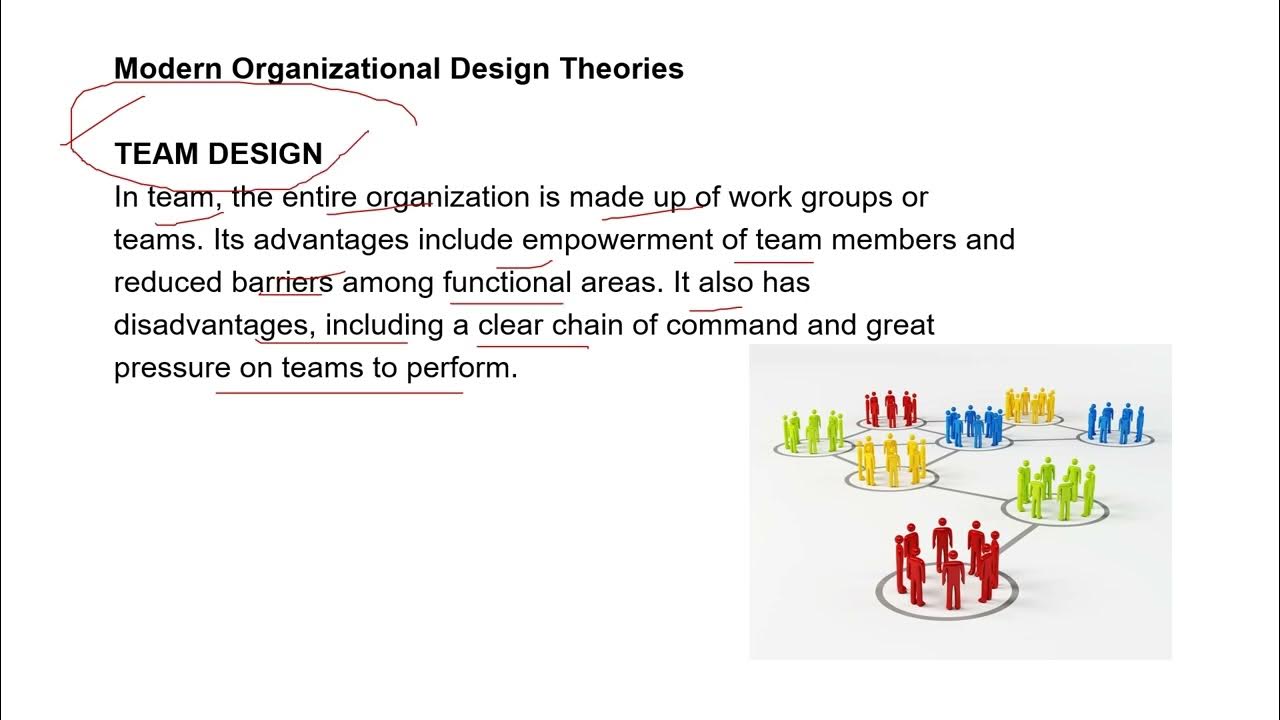GNG Business studies | Day 6 | Chapter 5 | Class 12 | Organising
Summary
TLDRThis video discusses organizational structures, focusing on functional and divisional models. It explains how functional structures lead to departmental specialization but may create coordination issues and inflexibility. On the other hand, divisional structures, suited for multi-product companies, offer more autonomy, accountability, and flexibility but can result in higher costs and conflicts. The video highlights the challenges of scaling organizations, balancing autonomy with interdepartmental collaboration, and the need for proper structure as a company grows. The key takeaway is the importance of choosing the right structure based on organizational needs and goals.
Takeaways
- 😀 Functional structure divides work based on specialized roles, but it can limit flexibility and inter-department coordination.
- 😀 As departments grow, they become more interdependent, creating coordination challenges between departments like sales and production.
- 😀 In functional structures, coordination issues arise because departments may prioritize their own objectives over organizational goals.
- 😀 Inflexibility in functional structures occurs because employees are trained for specific tasks and cannot easily switch roles.
- 😀 Divisional structure is ideal for multi-product companies, where divisions are organized based on product types.
- 😀 Divisional structure helps in the growth and expansion of a company by dividing work based on products or services offered.
- 😀 Accountability is higher in divisional structures because each division is held responsible for its own profit and performance.
- 😀 Divisional structures allow for specialization within product categories, developing skilled divisional heads and employees.
- 😀 The divisional structure promotes flexibility, as it allows for cross-departmental resource sharing, such as sending employees between divisions if needed.
- 😀 A key disadvantage of divisional structures is that they can be costly due to the duplication of roles and resources across multiple divisions.
- 😀 Conflict between divisions can arise due to competition for resources and attention, leading to conflicts of interest within the company.
Q & A
What is the key focus of the functional structure in an organization?
-The functional structure focuses on dividing the organization into different departments based on specialized functions such as sales, production, and finance. Each department focuses on a specific task, which promotes specialization.
What are the main challenges faced with the functional structure?
-The main challenges include problems with coordination between departments, conflicts of interest due to different approaches, and inflexibility as employees are trained for only one specific function.
Why does the functional structure create coordination problems?
-Coordination problems arise because each department focuses on its own task, and the employees within each department do not always communicate or collaborate effectively with other departments. This inter-departmental separation can hinder smooth operations.
What does 'conflict of interest' mean in the context of a functional structure?
-A conflict of interest refers to the differing goals, priorities, and mindsets of employees in various departments. As each department has its own focus, it can lead to disagreements and competition, disrupting the organization’s overall harmony.
What does inflexibility mean in a functional structure?
-Inflexibility in a functional structure refers to the limitation where employees are trained only for one specific task. If they need to cover tasks outside their department (e.g., during a colleague's absence), they may not be able to perform effectively, leading to inefficiencies.
What is the divisional structure used for in organizations?
-The divisional structure is used for organizations that produce multiple products or serve different regions. It divides the organization into separate business units based on product lines or geographical areas to streamline operations and management.
What are the advantages of a divisional structure?
-The divisional structure promotes expansion and growth by allowing the organization to scale its operations. It offers greater accountability, as each division is responsible for its profits and costs. It also provides specialization in managing specific products or regions, and offers flexibility in handling staff shortages.
How does the divisional structure increase accountability within an organization?
-Accountability in a divisional structure is enhanced because each division operates as an autonomous unit, and profits and costs can be clearly tracked for each division. This makes it easier to hold divisional heads accountable for their performance.
What are the disadvantages of the divisional structure?
-The divisional structure can lead to conflicts between divisions, increase operational costs due to having separate units for each product or region, and result in divisions focusing more on their own goals rather than the overall organizational objectives.
How does the divisional structure promote flexibility compared to the functional structure?
-The divisional structure is more flexible because each division operates independently. If a division faces staffing issues, other divisions can help without major disruptions. In contrast, the functional structure is inflexible since employees are trained for only one specific function.
Outlines

Esta sección está disponible solo para usuarios con suscripción. Por favor, mejora tu plan para acceder a esta parte.
Mejorar ahoraMindmap

Esta sección está disponible solo para usuarios con suscripción. Por favor, mejora tu plan para acceder a esta parte.
Mejorar ahoraKeywords

Esta sección está disponible solo para usuarios con suscripción. Por favor, mejora tu plan para acceder a esta parte.
Mejorar ahoraHighlights

Esta sección está disponible solo para usuarios con suscripción. Por favor, mejora tu plan para acceder a esta parte.
Mejorar ahoraTranscripts

Esta sección está disponible solo para usuarios con suscripción. Por favor, mejora tu plan para acceder a esta parte.
Mejorar ahora5.0 / 5 (0 votes)






